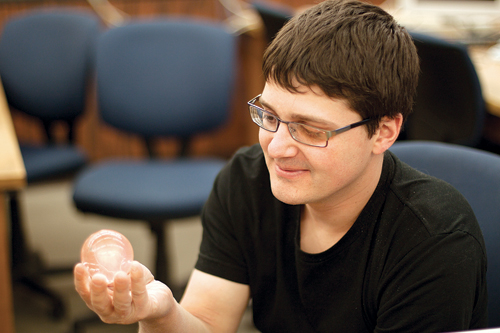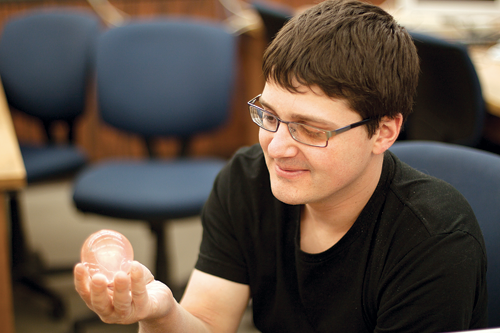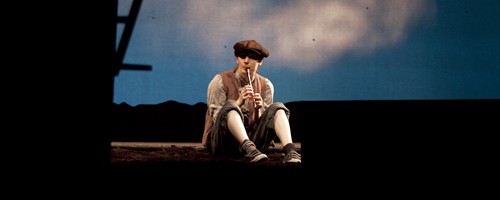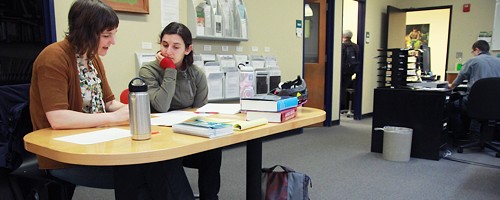It’s Wednesday morning, and Portland State physics Professor Ralf Widenhorn isn’t standing at the front of a lecture hall, he is bright-eyed and addressing students in a research lab. Beakers and supplies are strewn all around, and in the back, one student balances on a scale to help plan a demonstration, with data being reported in real time in a graph on the computer. The PSU Science Outreach Society is deep in the planning stage of its next demonstration to be held at the Bagdad Theater in Southeast Portland.
Science Outreach Society bridges gap in science education


It’s Wednesday morning, and Portland State physics Professor Ralf Widenhorn isn’t standing at the front of a lecture hall, he is bright-eyed and addressing students in a research lab. Beakers and supplies are strewn all around, and in the back, one student balances on a scale to help plan a demonstration, with data being reported in real time in a graph on the computer. The PSU Science Outreach Society is deep in the planning stage of its next demonstration to be held at the Bagdad Theater in Southeast Portland.
A nonprofit student group, the SOS’s basic goal is to bring scientific concepts to the Portland general community in an engaging manner. This is accomplished through demonstrations that combine showmanship with an underlying scientific concept. While the presenter grabs the audience’s attention with a dramatic demonstration, he explains the science of why it works. The SOS doesn’t charge for its demonstrations.
“Science can be cool, not just a nerdy thing. We want to be showing something that can be fun,” Widenhorn said. He explained that the shows frequently use different themes as needed. “For one show, we will have an electricity theme, and in another show we will have an explosion theme.” The demonstrations are usually done by teams of thee to four students who have spent time together researching the science and rehearsing the performance.
Widenhorn founded the SOS, the idea coming to him while he gave a demonstration at the Bagdad Science Pub in 2010. He decided there was a lot of potential for similar activities with the science students at PSU. “I thought it would really be nice to get some of the knowledge into the community,” he said.
Physics graduate student Justin Dunlap steps in front of beakers that had been set up earlier in the planning meeting to show the Vanguard one of the light-themed experiments, called Invisible Spheres. Dunlapholds up a polycrylamide sphere to the light for everyone to see. It is the size of a marble, transparent and feels a little bit like Jello. Then he drops the sphere into a small beaker of water, and by all appearances it disappears. The beaker looks like it’s simply filled with clear water, with no appearances that anything else is inside it.
“There are also biologists that work with us,” Dunlap said. He reaches into the beaker and pulls out two of the polycrylamide spheres, seemingly bringing out the second sphere from nowhere. “See? It multiplied.” Dunlap grinned sheepishly and explained they are still working on their jokes, and that this is just a planning meeting. The younger kids who see the demonstrations especially love the Invisible Spheres experiment, Dunlap said.
The idea of the experiment is to demonstrate some of the principles behind index of refraction, Dunlap said. There is an honest enthusiasm that begins to show on his face as he starts explaining the science behind the experiment the way he would to a crowd. “The index of refraction is how fast the light can go through an object. When the water is added, it bends the light so that the index is the same,” he said. This is what creates the perfect illusion of invisibility.
Widenhorn explained that public school funding is low and student-teacher ratio in many public school classrooms is high, and that it really helps out the teachers when the society can go into the classroom and get the kids excited while also teaching them. Since its inception, SOS has made demonstrations in many local public schools as well as at daycare centers, Boys and Girls Clubs and science expos.
Chemistry graduate student Nick Day explained that presenting for the club has helped make him more clear about the material he is teaching. “Being able to pitch what we have to a sixth or a 12th grader has really helped me be a better presenter,” he said.
The SOS isn’t just limited to people from the physics department, or even students studying the sciences. “One thing I want to stress,” Widenhorn said, “is that the club is interdisciplinary.” SOS has use for the knowledge and skills of all science majors or even interested students from other majors. One of the eventual goals of the club is to be on-call and available to quickly leave and perform demonstrations, and this becomes easier with larger membership.
The club has been slowly growing since its inception, and is being recognized by the Student Activities and Leadership Program office as an official club for the 2012–13 school year.
There are currently about 60 members in the club, with membership constantly in flux as students graduate and new students come in. The SOS meets monthly, and the next meeting will be May 23 at 4 p.m. in the Science Research and Teaching Center, room 113. All interested are welcome to attend.






